This time last year, nobody outside of Moldova had really heard of Sheriff Tiraspol, a club founded in 1997, presiding in an unrecognised breakaway state called Transnistria.
However, on September 28, 2021, Sheriff would become a household name in Europe. In one of the most shocking results in the modern history of the UEFA Champions League, the Wasps rocked up to a great gallery of football, named the Santiago Bernabéu, and took all three points against Carlo Ancelotti’s Real Madrid.
Los Blancos proceeded to crack on and win the competition, making Sheriff’s feat all the more admirable. In a realm where big almost always crushes small, Sheriff proved to the world that sometimes David can actually conquer Goliath.
Nevertheless, in the summer, there was a change of management at the Sheriff Stadium. Yuriy Vernydub, who guided the Moldovan side to the historic victory in Spain, stepped down from his role to join the Ukrainian Armed Forces. His replacement was the former Croatia international Stjepan Tomas.
This season, while not reaching the heights of club football’s greatest competition, Sheriff Tiraspol still qualified for the UEFA Europa League and started wonderfully, thrashing Neil Lennon’s Omonia Nicosia 3-0 out in Cyprus and will also have the chance to travel to Old Trafford in a few weeks’ time to face Manchester United.
In the Moldovan Super Liga, Sheriff are top once again and are unbeaten under Tomas’ tutelage. So in this tactical analysis piece, we have decided to write a team scout report, looking at the tactics employed by the new boss, showing why Sheriff are not to be messed with once again in Europe.
Formation changes
There has been a slight changeover in terms of the team’s tactical style and shape since Tomas took over in the summer compared to when Vernydub sat in the dugout. The new boss has his players playing a bit more progressively compared to his predecessor.
Last season, Vernydub was adamant about deploying the 4-2-3-1, giving Sheriff more defensive balance in the middle of the park. This conventional system was used in 58 percent of the Moldovan champions’ games.
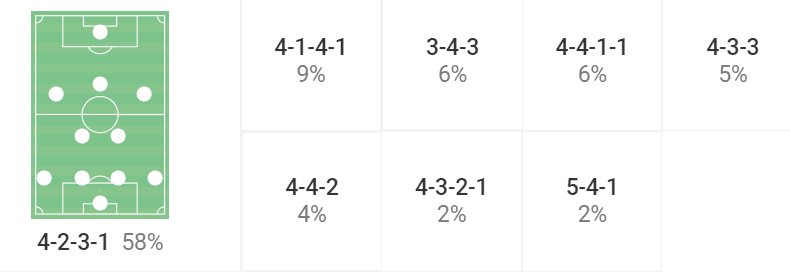
There was a bit more tactical flexibility under Vernydub than Tomas as the former was willing to bend to the opponents on the day, particularly in games against better opposition such as in the Champions League. As such, Sheriff also lined out in a 4-3-3 at times, as well as a 3-4-3, a 4-4-2, and a 4-4-1-1.
Tomas was searching for a bit more offensive control in the team as he was keen to transition the Wasps into more of a possession-based outfit. To do so, the manager switched Sheriff’s go-to shape from a 4-2-3-1 into a 4-3-3, using a single pivot as the base of a midfield three.
So far this season, across all competitions, Sheriff Tiraspol have set up in a 4-3-3 base formation in 71 percent of their matches. This includes the 4-1-4-1 which is merely the 4-3-3 but with the wingers positioned lower during the defensive phases.
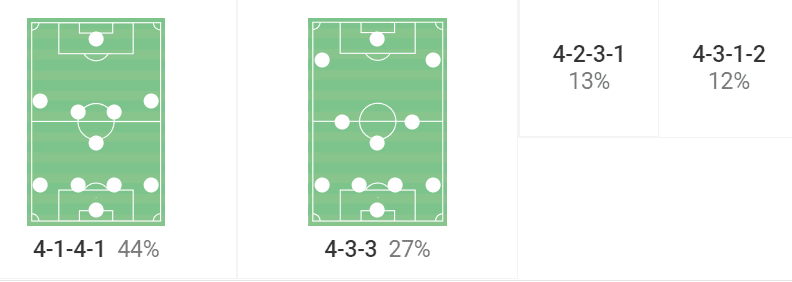
However, as can be seen from the above graphic, there have been times when Tomas has had to call upon the 4-2-3-1, and even tested the more unorthodox 4-3-1-2.
In the opening game of the UEL, the 46-year-old started with a 4-3-1-2 in order to block out Omonia’s options in the middle of the park. After taking the lead, the manager quickly changed to a 4-2-3-1 to provide more defensive security, especially down the flanks as the Cypriot side were knocking on the door by putting crosses into the box.
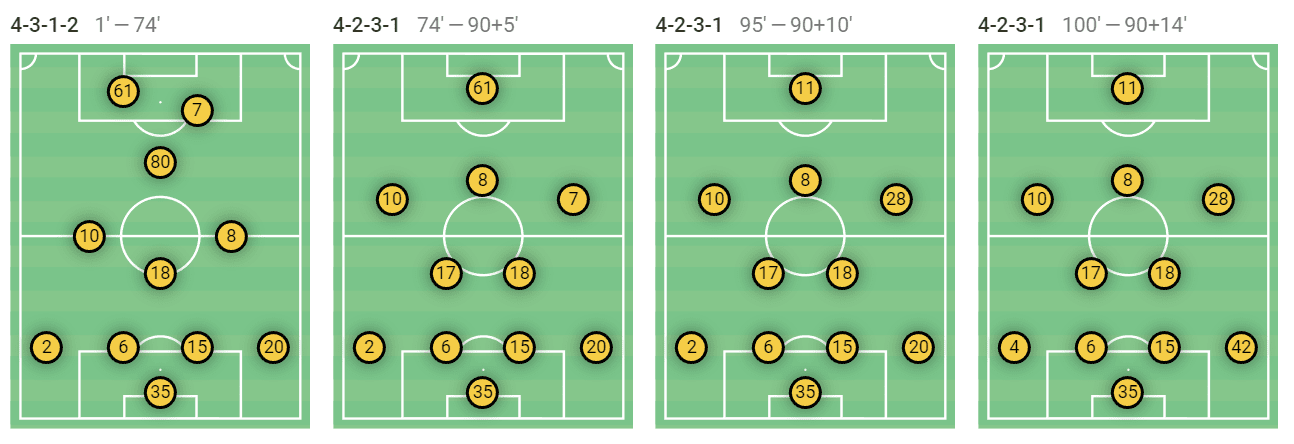
While not being as willing to bend to the opponents as Vernydub, Tomas’ version of Sheriff have not really had to due to the team being more capable of holding possession when necessary but also still being concrete out of possession.
Last season, the Wasps averaged 52.81 percent possession in all competitions. This has increased to 56.77 percent this time around.
But how exactly do Sheriff use their newfound ball domination in games to break down their opponents? Let’s take a look.
Building out wide
A manager’s job is to get the most out of the players at their disposal. As mentioned previously, Tomas is keen for his players to employ a possession-based style of football but there needs to be a hint of pragmatism within this ideology.
Teams like Manchester City, Chelsea and Liverpool are able to build up through the thirds of the pitch from the central areas. However, this requires an incredible amount of technical skill in the middle of the park to be able to pass through the opposition’s lines consistently.
Staying somewhat pragmatic, Tomas instructs his players to build down the flanks instead.
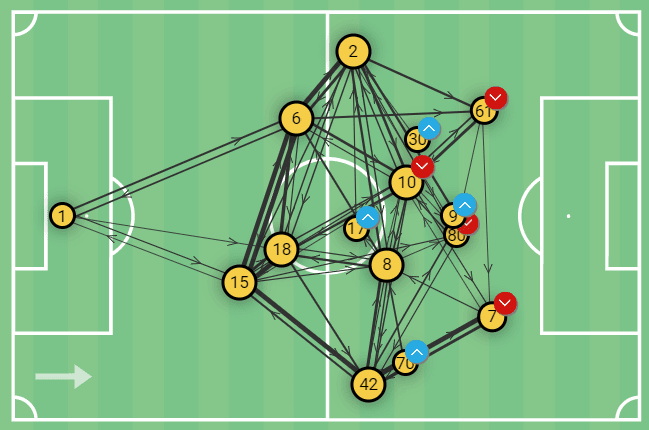
We can see this from the team’s passing network against Pyunik in the Europa League playoffs last month. What is evident is that the links from the fullbacks to the wingers are some of the strongest in the entire chain.
What’s also noticeable though is that there is quite a lot of ball circulation occurring among the backline and with the goalkeeper and single pivot. This is because, initially, Sheriff look to move the ball around slowly, hoping that the opposition step out to press which could open gaps inside the defensive block to play centrally.
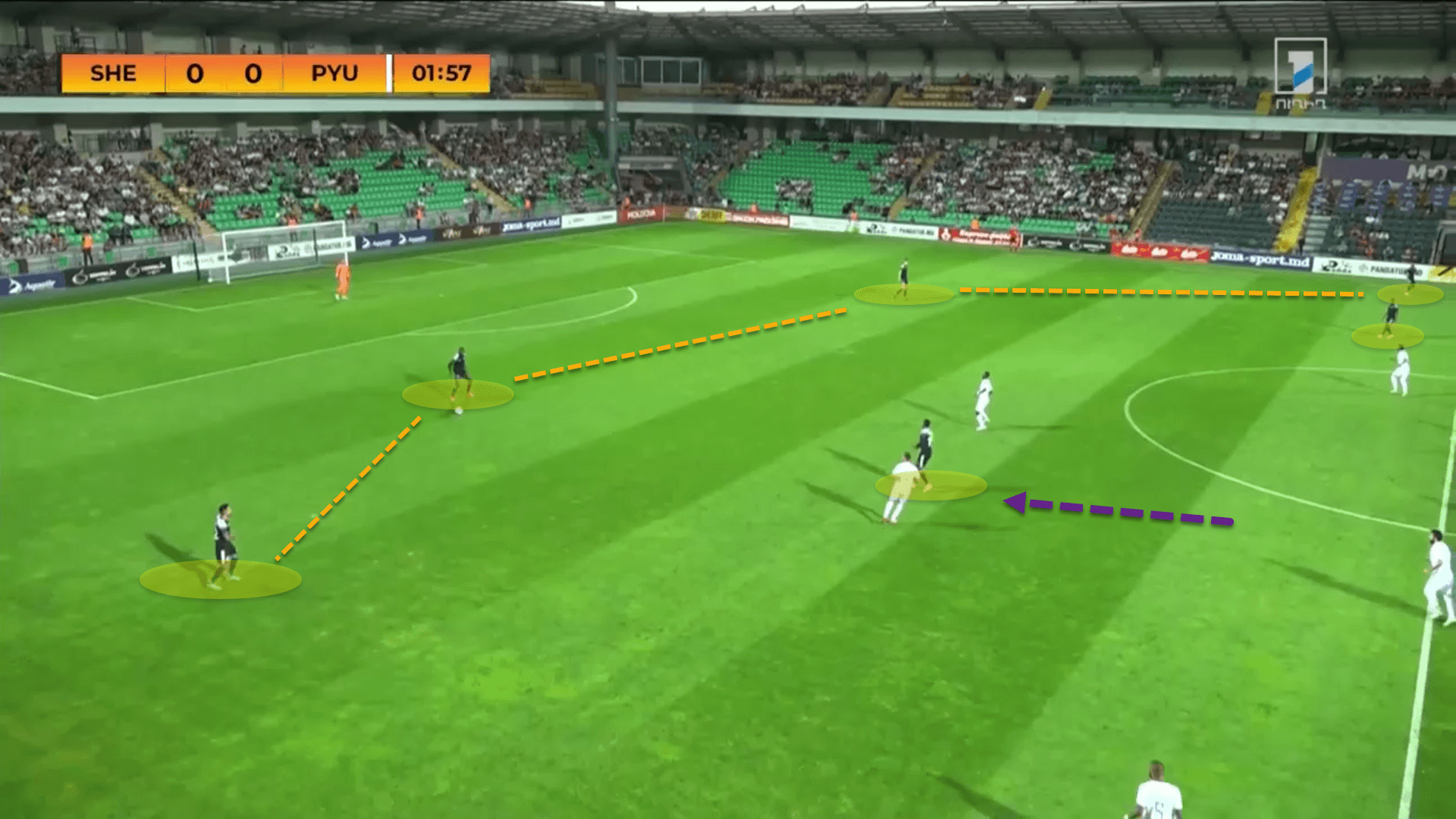
When building out from deep, Sheriff maintain their 4-3-3 base structure. The fullbacks remain low instead of pushing high in order to comfortably receive the ball from the centre-backs, aiding with circulation.
Meanwhile, the single-pivot positions himself between or just behind the opponent’s first line of pressure, whilst the two advanced central midfielders push behind the second line, between the lines of the midfield and defence.
The wingers keep the width high up the pitch and the centre-forward occupies the opposition’s centre-backs. This is pretty standard and is perhaps the most common 4-3-3 structure in possession.
If Sheriff can play through the central areas then they will, but this option is not always available and so the Wasps tend to progress the ball up the flanks. They use wide rotations to facilitate this.
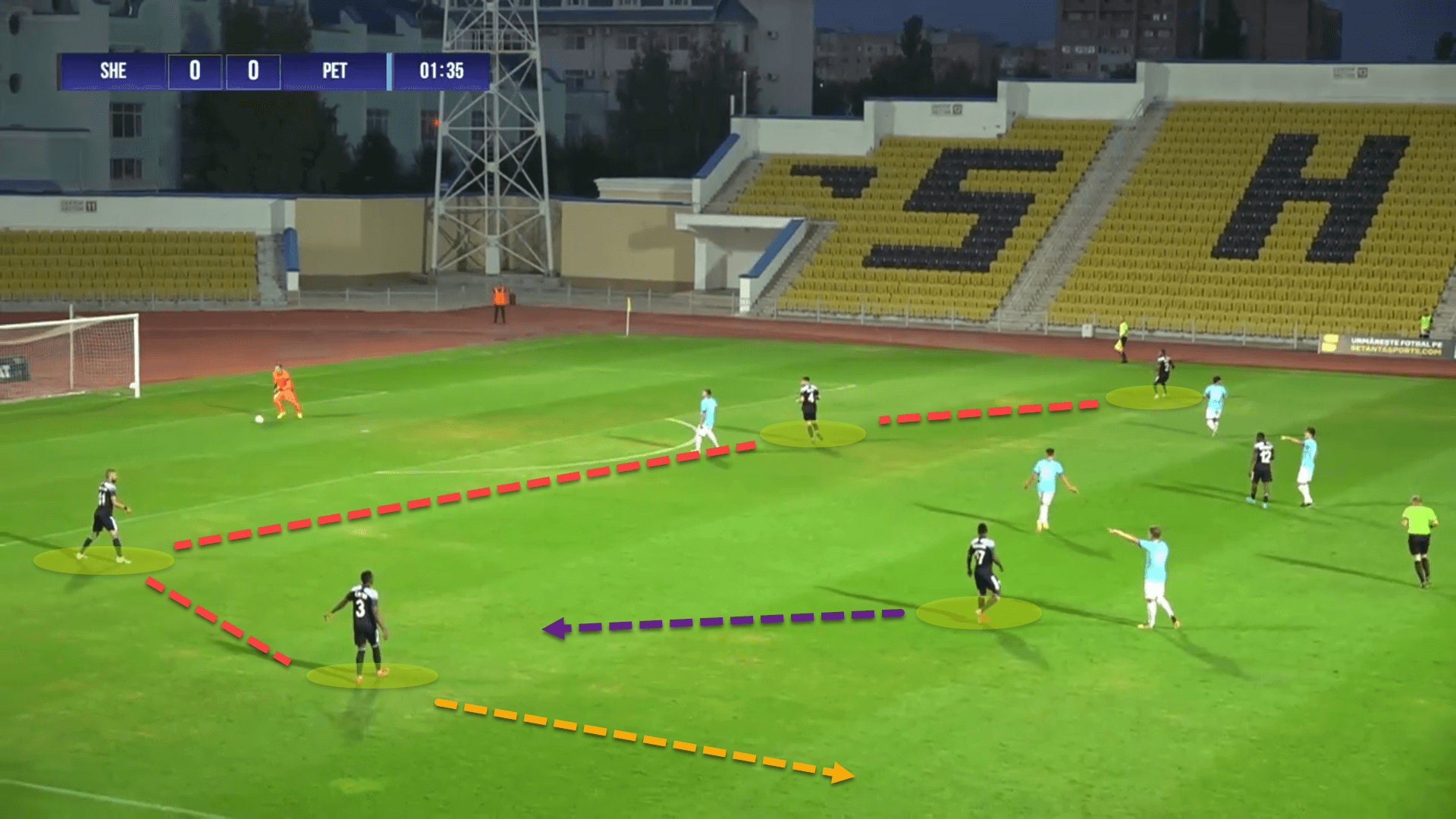
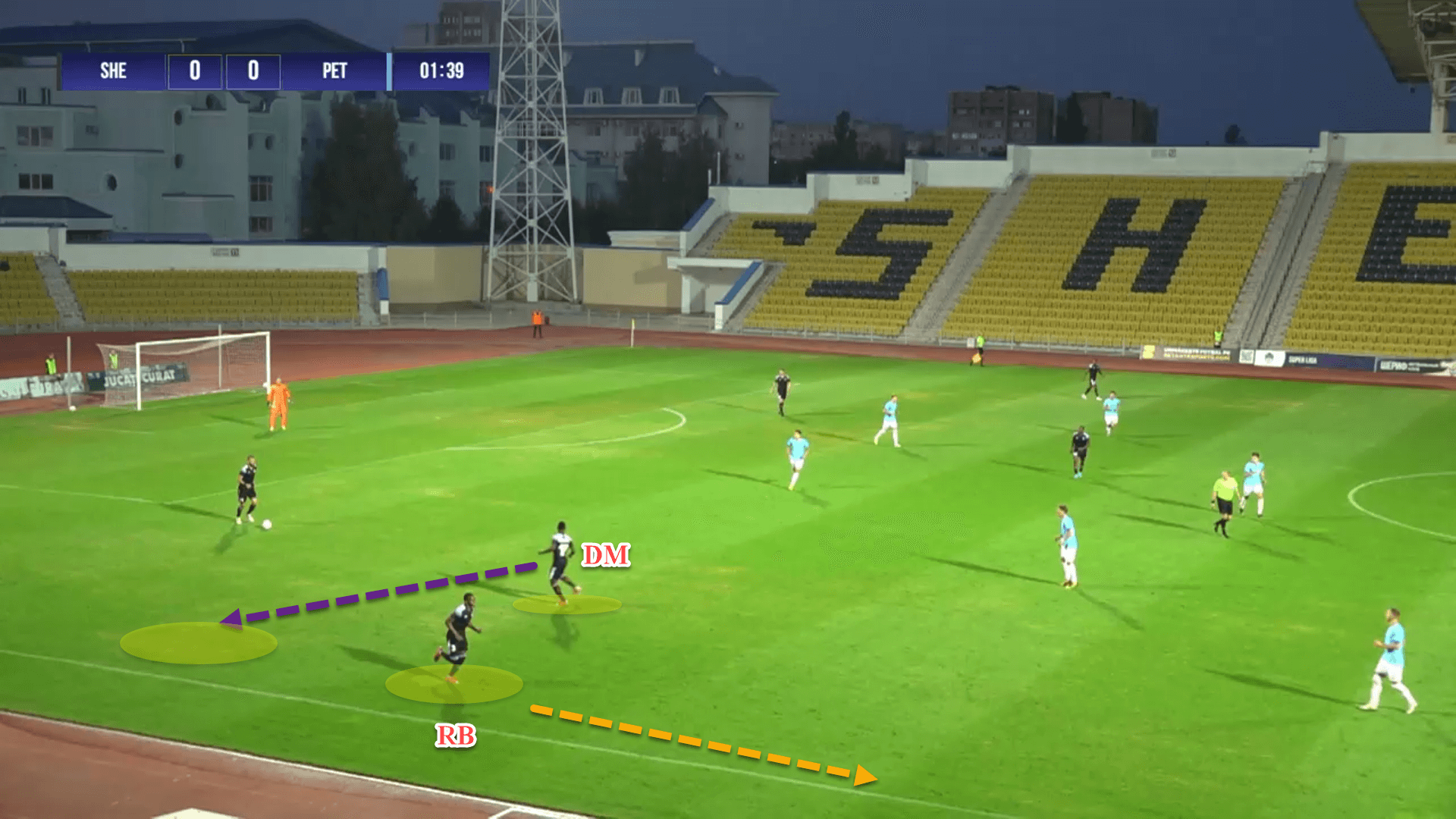
Again, the rotations are rather basic but are still effective and get the most out of the players available.
The two images above portray the Sheriff players triggering the team’s most common rotation which is to drop the number ‘6’ beside the centre-backs, allowing the fullbacks to move up higher in the wide areas.
In the first example, we can see Sheriff’s right-back during the game, John Charles Petro, signalling towards the single pivot to drop into his spot which would free the fullback to move up the flanks. From there, he is able to receive the ball in a higher position to progress play without losing any defensive balance at the back.
Mali international Moussa Kyabou has primarily been used as the team’s ‘6’ due to his defensive awareness and comfortability on the ball. This is one of the reasons why Kyabou is the main source of ball progression for Sheriff Tiraspol.
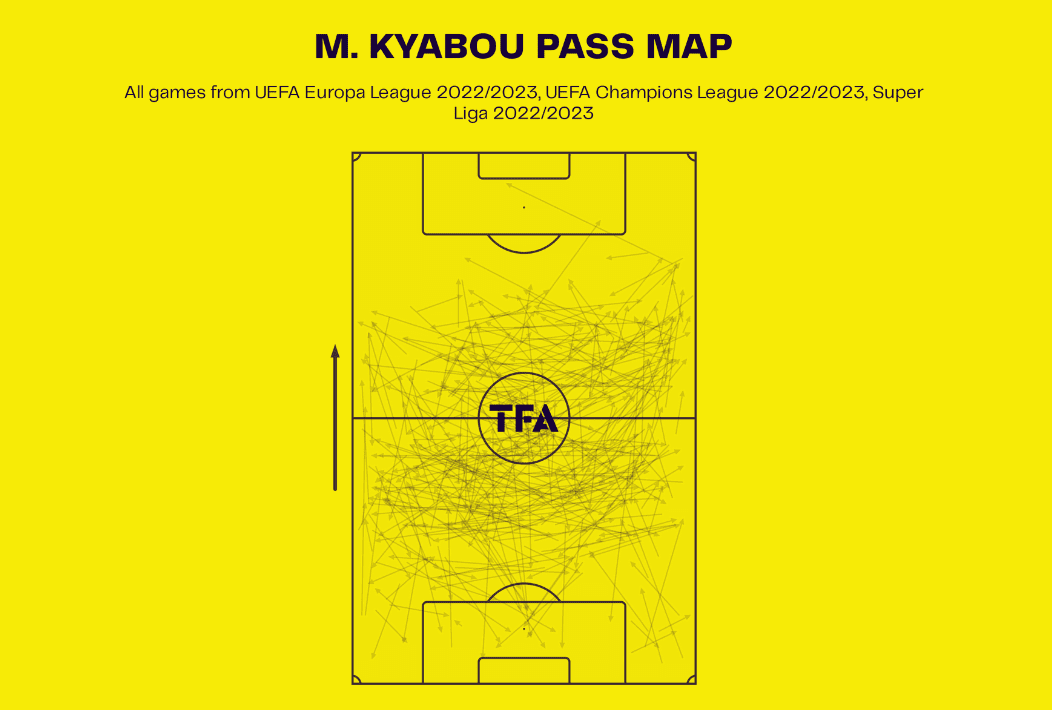
From his pass map this season in all competitions, one can see just how deep Kyabou plays his passes. This proves that the 24-year-old is practically the link man, tasked with taking the ball from the back and moving it up the pitch.
The following two images show how vital Kyabou’s involvement is:
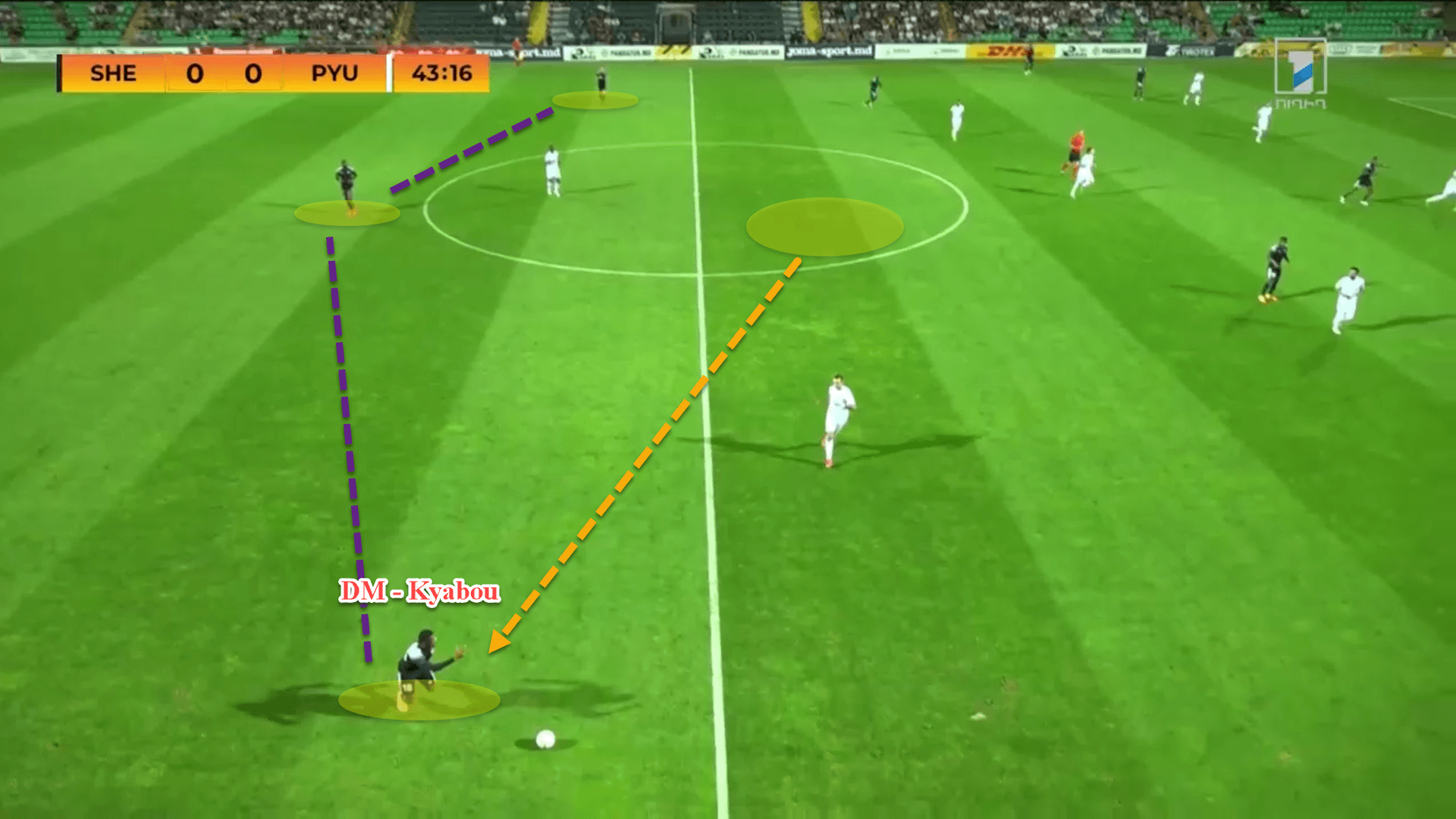
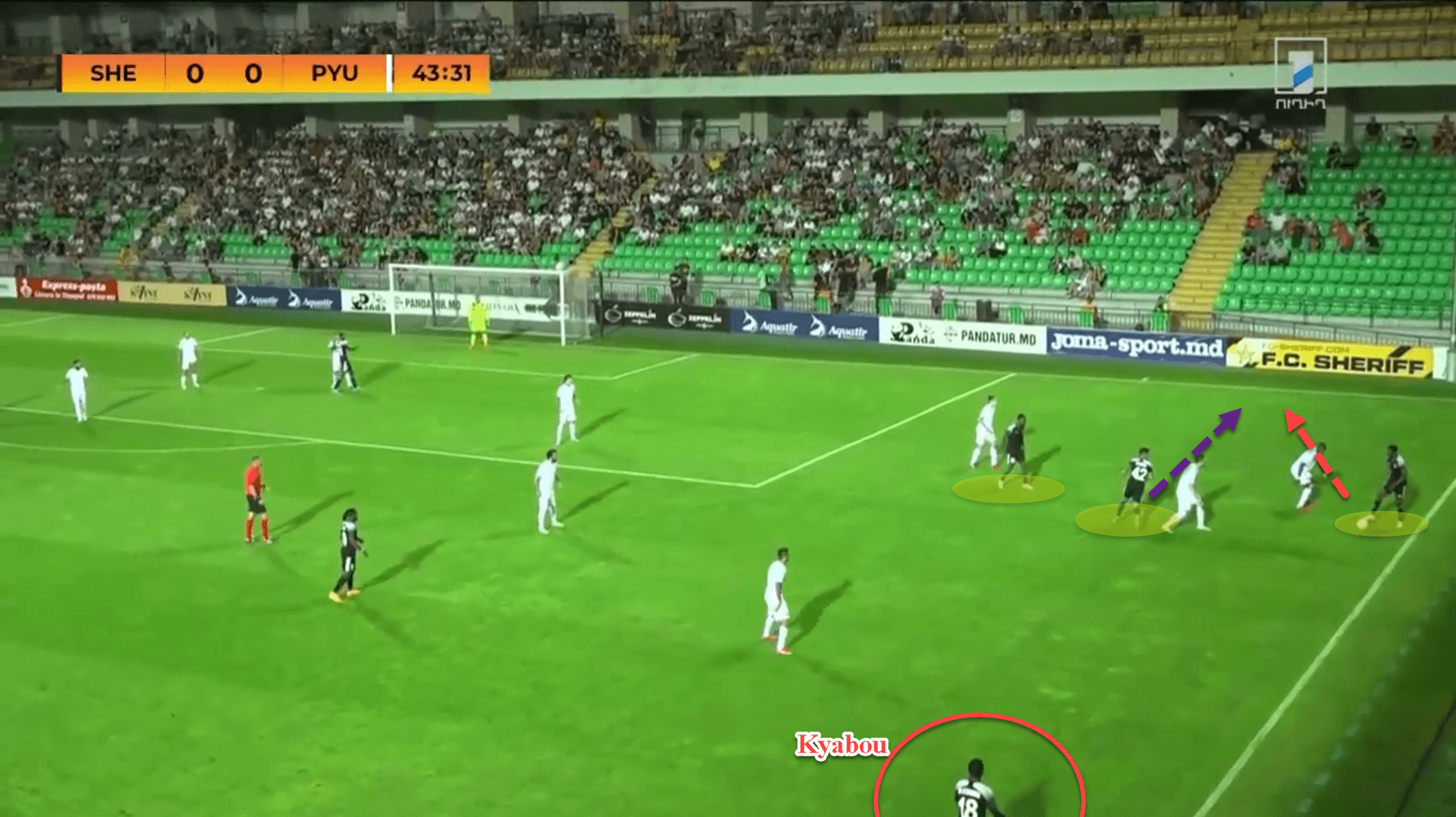
The pivot player receives the ball from the centre-backs after creating a back three and allowing the fullbacks to push high up the pitch. From there, he uses his passing ability to progress play to the wide players in the final third, putting Sheriff in a dangerous position.
Again, this isn’t ground-breaking stuff from the Moldovan champions, but Tomas has proven that his side can play a purposeful, yet pragmatic possession game.
The importance of crosses
Sticking with the idea of pragmatism, Tomas understands that his players don’t really possess the technical quality needed to break down an opponent’s low block through the central areas, less commonly known as Zone 14 which is the space just outside the 18-yard box.
Instead, the Croatian manager instructs his players to put plenty of crosses into the box, especially when Nigerian centre-forward Iyayi Atiemwen is on the bench given the striker’s 180cm height.
In the playoff game against Pyunik, Sheriff whipped 38 crosses into the penalty area across the full ninety minutes plus thirty minutes of added time.
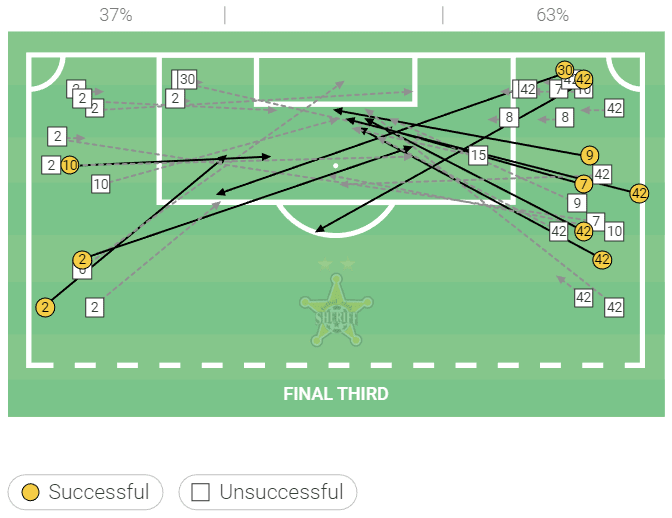
When performing an analysis of all the areas where Sheriff Tiraspol’s crossed the ball, there is no clear pattern unlike teams such as Liverpool who are hell-bent on having their fullbacks provide deep crosses, often from the halfspaces.
The Wasps merely cross when it is applicable to do so. Tomas’ side create wide overloads in the final third and the players execute combination play, trying to get one of the players free in space.
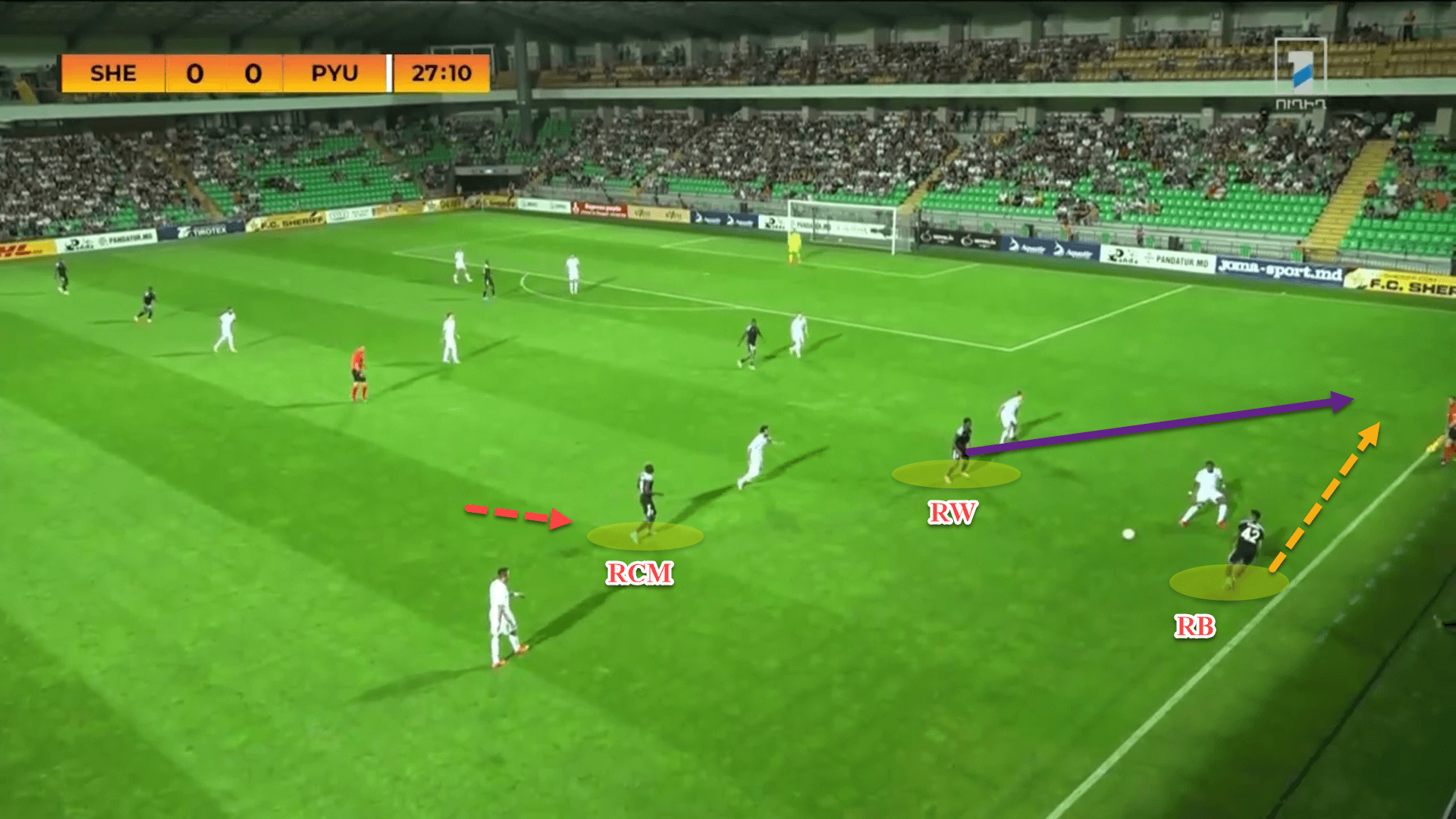
In this image, the right central midfielder, right-back and right-winger have all formed a triangle near the touchline. From a quick one-two, the right winger, Abou Ouattara, slips right-back Renan Guedes in behind the opposition’s fullback, allowing the Brazilian to get himself in space to cross.
Going back to an earlier point about the single pivot dropping to the side of the centre-backs to act as an auxiliary fullback, we can get a sense of the importance of this.
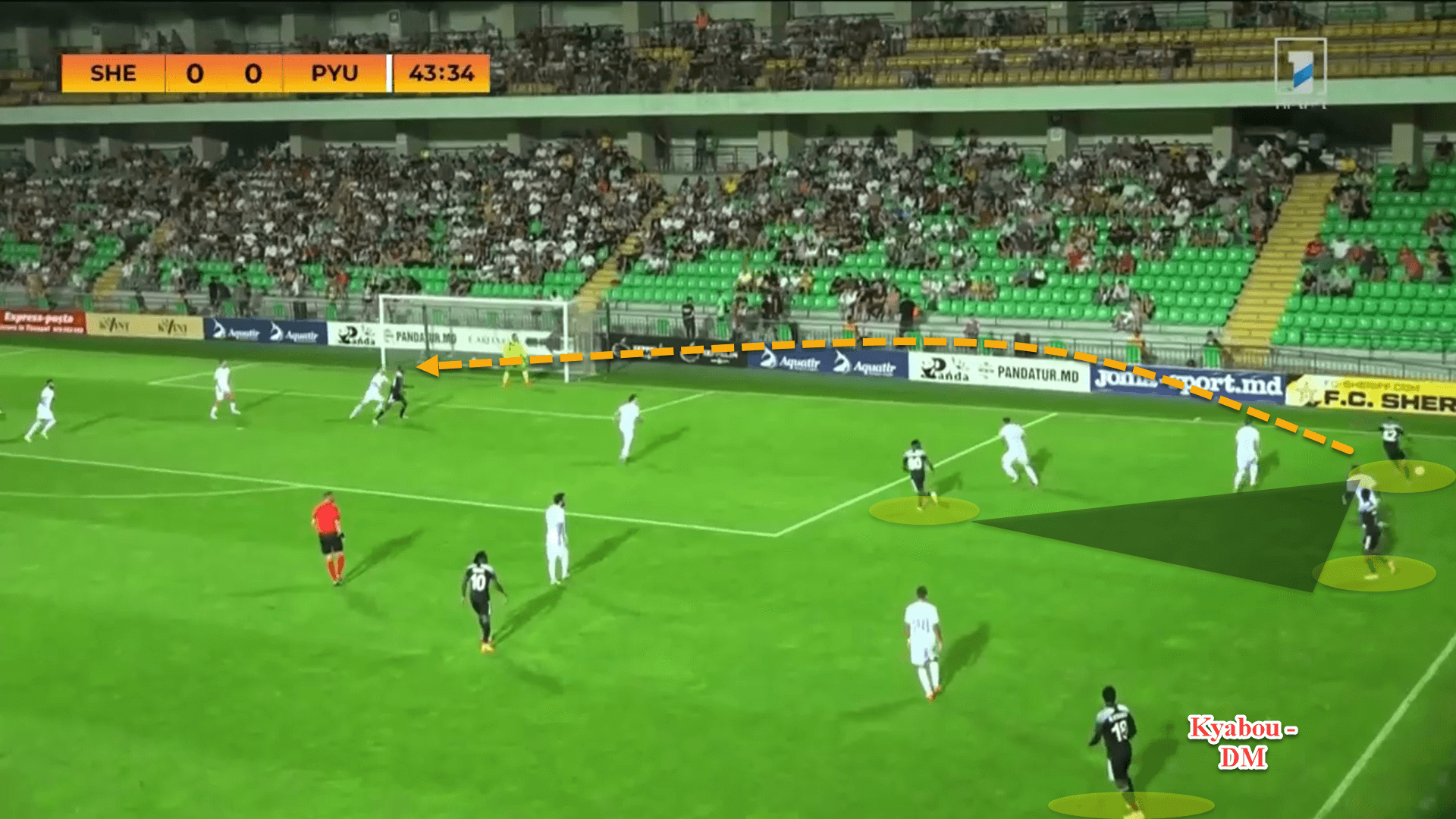
Here, again, Sheriff have created a triangle out wide to try and force a crossing opportunity. Kyabou is sitting under the player. This allows him to act as a backwards passing option to recycle play in case the ball needs to be shifted to the opposite side but also ensures that, in case Sheriff lose the ball, he can quickly step up to counterpress as the team attempt to regain possession.
So far this season in all competitions, the Wasps have averaged 17.13 crosses into the penalty area per game with an accuracy of 31 percent.
The team have scored just one headed goal, but the sample size is rather small. Comparing this to last season, Sheriff bagged 12 headed goals, the joint-most in the division, so there’s definitely a method to the repetitive madness from Tomas’ men.
Inverted pressing
Passes allowed Per Defensive Action (PPDA) and challenge intensity are the two best metrics to determine how high a team presses up the pitch.
With PPDA, the lower the number the better as the defending side allows the opponent to have less of the ball. Meanwhile, challenge intensity quantifies how many defensive actions a team makes per minute of opposition possession.
Sheriff’s PPDA this season in the Moldovan Super Liga stands at 7.91 which is the lowest in the division. The champions boast a challenge intensity of 5.9, the highest in the league. By default, Sheriff are the highest pressing team in Moldova’s top tier.
Does this change during European nights? The short answer is no. Against Viktoria Plzeň in the first leg of the UEFA Champions League third qualifying round, Sheriff’s PPDA was actually 6.62, increasing slightly to 7 in the second round, but both numbers were below the league average interestingly.
Even recently against Omonia in the UEL opener, Sheriff’s PPDA was 8.46 which is an incline on the team’s average but is still quite low.
So how exactly do Sheriff press and cause problems for the opposition?
Tomas wants his players to press invertedly. This is the opposite of what most sides do. Usually, teams press inwards to outwards, forcing their opponents to play to the wide areas where they can create aggressive pressing traps to win the ball back, using the limitations of the touchline as an extra defender.
Here is an example of Athletic Club coercing Valencia into a wide pressing trap, something the Basque side do incredibly well under Ernesto Valverde this season:
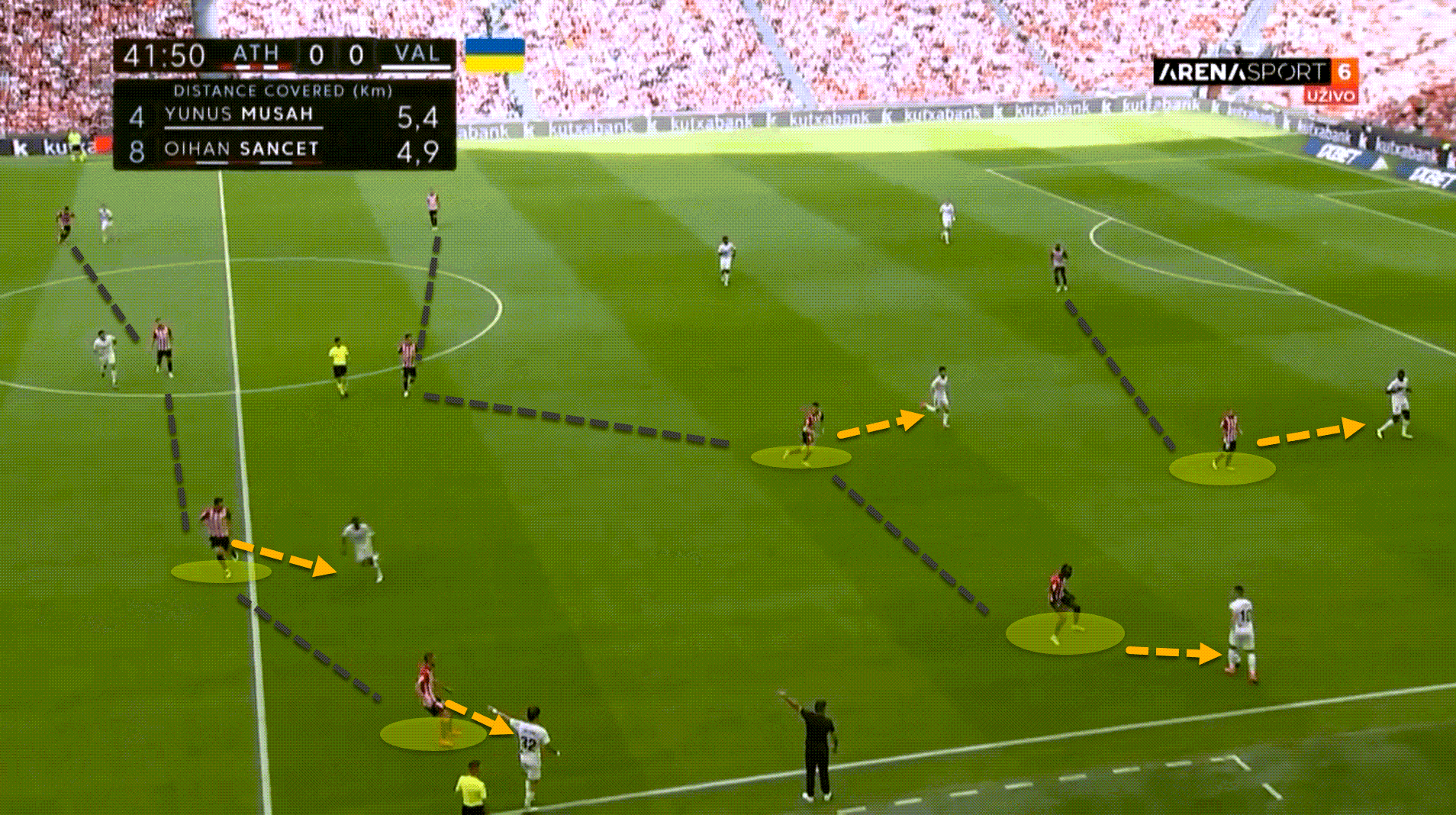
Sheriff don’t adhere to this. Instead, the wingers, or centre-forwards, depending on the team’s formation, press from out to in. The hope from this is that it will force the attacking side to play inside where their players are being marked.
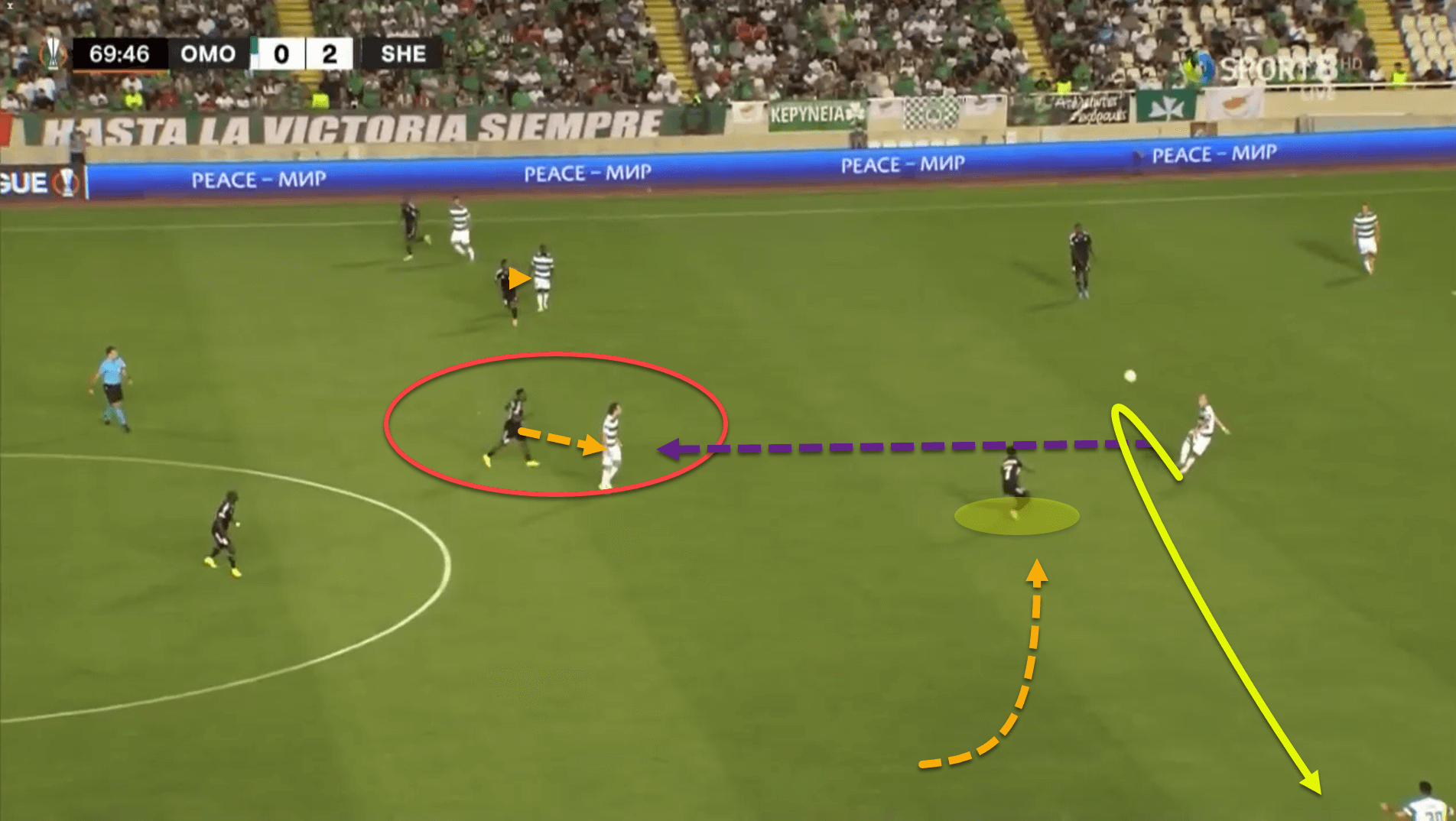
In this scenario, Ouattara, playing as the right-sided striker in a 4-3-1-2, is invertedly pressing the Omonia centre-back with the aim of manipulating the defender into playing forward where his teammates are being marked.
Unfortunately, this attempt fails, and the player switches it out to the fullback. Once this happens, Sheriff then drop into a deeper defensive block, looking to consolidate space between the lines.
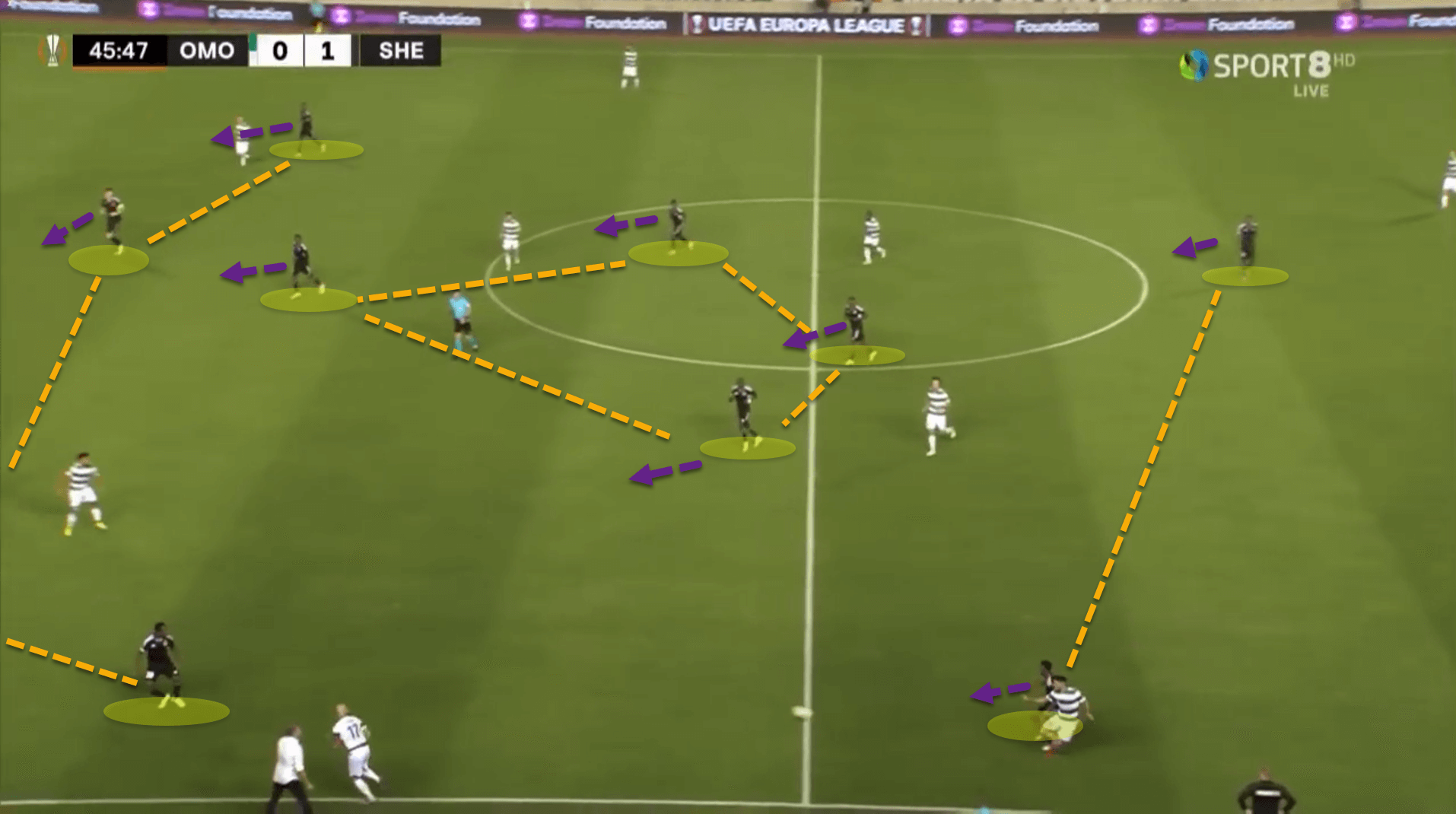
This season in all competition, the Wasps have conceded an xG of merely 0.67 per game, showing their solidity in the defensive phases. The players all work together in unison and can be incredibly difficult to break down.
Sheriff’s group in the Europa League is certainly a difficult one but Tomas’ side won’t go down without a fight and their excellent defensive record could be crucial if they are to remain fighting among Europe’s elite.
Conclusion
Under new guidance from the touchline, Sheriff Tiraspol look better than ever and are on course to retain their Super Liga crown, albeit early days still.
Even a third-place finish in the UEL group phase would be enough to secure the team’s progression in Europe as the Wasps would drop down to the UEFA Europa Conference League.
Deploying a stunning, but pragmatic style of football, Sheriff will be one to watch in European football yet again in this campaign and could cause some upsets along the way as they did on that memorable night last September.





Comments